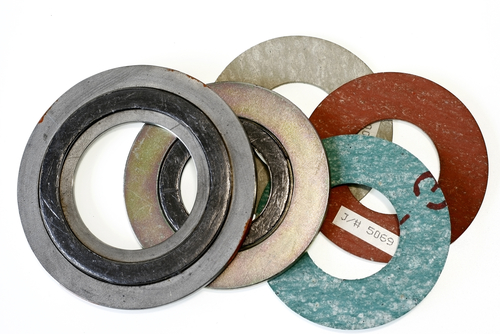A gasket’s function is to interpose a semi-plastic material between the flange facings, the material which, through deformation under load seals the minute surface irregularities to prevent leakage of the fluid. Generally, gaskets can be divided into three main categories: Non-metallic gaskets, Semi-metallic gaskets and Metallic gaskets.
Many types of gaskets are constructed from metal or a mixture of metal and non-metal materials. They are typically formed with aluminum, copper, nickel, steel, stainless steel or brass. A high level of thermal, corrosive and pressure resistance are provided by these materials, along with excellent durability and tensile strength. Conversely, metals require elevated amounts of compressive force to form a seal and have limited flexibility for multiple applications. As a result, metals are often used in combination with rubber or plastic compounds, otherwise known as soft fillers.
Metallic Gaskets
Metallic gaskets are fabricated from one or a combination of metals to the desired shape and size. A common metallic gasket is the ring-joint gasket and lens rings. It is ideal for high-pressure and temperature applications and requires high bolt load to seal.
Semi-Metallic Gaskets
Semi-metallic gaskets are composites of metal and non-metallic materials. The non-metallic portion of the gasket provides comformability and seal-ability, while the metal is intended to offer strength and resiliency. Commonly used semi-metallic gaskets include spiral wound, metal jacketed, Kammprofile and a variety of metal-reinforced graphite gaskets.
These gaskets are designed for the widest range of operating conditions of temperature and pressure. They are used on raised face, male-and-female and tongue-and-groove flanges.
Spiral wound gaskets are utilized for high temperature and high-pressure applications. The main aspects of spiral wound gasket are metallic windings and filler material. The criteria for material selection of windings are: corrosive nature, fluid concentration, operating temperature and material cost. For winding, commonly used material includes Stainless steel 304, 316 and 321. Depending upon the services, alternative winding material may also be used. General filler material used are Asbestos and graphite. For high temperature application, graphite filler is recommended.
Spiral wound gasket are provided with the outer centering ring made up of Carbon Steel for proper positioning. In Vacuum service application they are provided with the inner ring. The material of the ring should be compatible with the process fluid.
Non-Metallic Gaskets
Composite sheet materials are typically used with flat face flanges and low pressure class applications. These gaskets are manufactured non-asbestos material or Compressed Asbestos Fibre (CAF), Non-asbestos types include arimid fiber, glass fiber, elastomer, Teflon (PTFE) and flexible graphite. PTFE or RPTFE are used in high corrosive applications. Full face gasket types are ideal for use with flat-face (FF) flanges and flat-ring gasket types are ideal fur use with raised face (RF) flanges.
For more information on gaskets, don’t hesitate to contact us here at Bryan Hose and Gasket with the link below!


Roman Delino liked this on Facebook.
Charity Wilson liked this on Facebook.
Debra Wilson liked this on Facebook.
Bryan Hose & Gasket liked this on Facebook.
Dan Wilson liked this on Facebook.
Evelyn Zapata liked this on Facebook.
Butch Melton liked this on Facebook.
Rod Bernard liked this on Facebook.
Alton Lee liked this on Facebook.
Lorrissa Thorne liked this on Facebook.
Alvin Cantu liked this on Facebook.
Francisco Acosta liked this on Facebook.
Francisco J Baez liked this on Facebook.
Alejandro Vizcaino liked this on Facebook.
Bejad Boleng liked this on Facebook.